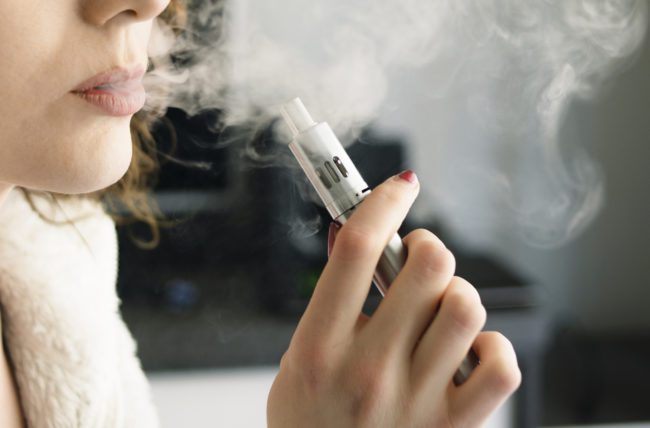“This has turned into a healthcare crisis”, Congressman Joseph Kennedy III (D-MA) said in 2019, referring to the then nascent vaping crisis.
It emerged out of an attempt to create a new smoking cessation option, but spawned its own set of addictive behaviors, particularly among adolescents. Or so we believed. Vaping, or e-cigarettes, which consist of a vaporizer and a liquid cartridge with a liquid nicotine solution, were initially touted as a safe alternative to cigarettes, and spunky startups arose evangelizing public safety, in their entrepreneurial zeal to bring these products to market. Soon the cartridges added various flavors to go along with the nicotine. Some contained marijuana. After a few short years on the market, there were over 400 flavors, and vaping became so popular among college students that use doubled from 2017 to 2018. That same year, 20 percent of Americans aged 18 or younger had used e-cigarettes in some capacity.
But by 2019, people were developing mysterious lung injuries severe enough to result in hospitalizations and even deaths. The New England Journal of Medicine called teen vaping an epidemic, and the CDC studied the cartridges to see what was causing these symptoms. Public policy experts and law enforcement went on the offensive, putting restrictions on what vaping flavors people could buy and where vaping could be done. Vaping drug busts made headlines, as highly publicized raids by local and federal law enforcement officers confiscated increasingly large amounts of illicit cartridges.
Yet high schoolers continued vaping, and in greater numbers. Surveys found that nearly one in four underaged Americans were vaping. Schools across the country joined the frontline offensive against the vaping crisis and increased drug testing in schools. Some began drug testing every student over the course of an academic year. Yet despite the increased restrictions, and increased publicity of the health risks, more teens continued to vape, resulting in more hospitalizations and more deaths.
Healthcare researchers struggled to make sense of it all. Sixty percent of vaping-related deaths involved only nicotine cartridges, but 80 percent of lung injuries requiring hospitalizations involved cartridges with both nicotine and THC. The median age of use was 23, but the median age of death was 53. And 80 percent of lung injuries came from users aged 35 or younger.
Although the data presented unfamiliar patterns of complications, lawmakers followed a familiar pattern of reacting with heightened restrictions and criminal investigations. High-profile investigations of vaping companies began, similarly targeting their marketing tactics. These were similarly reinterpreted to be aggressive and deceptive, as an attempt to create addictions among users. Everyone seemed to forget that the original intention of vaping had been to address cigarette addiction.
Vaping companies soon pushed back, demonstrating the value their product provides when used appropriately. When the state of Massachusetts instituted a statewide ban on vaping, the Vaping Technology Association fought the ban and began conducting research, demonstrating the value of vaping for patients struggling with nicotine addiction.
By resisting and changing the conversation from criminal behavior to clinical research, the vaping industry showed the benefits when used responsibly among certain users, emphasizing that the context around the behavior determines the clinical benefits or harms more than just the act of vaping.
Dr. Rachel King, Director of Addiction Psychology at Cornell, studied vaping as a viable treatment option for nicotine addiction, and found a relationship between vaping and cigarettes. In coupling vaping with cigarette smoking, she noted that by restricting one you promote the other, and vice versa. She then discovered that the vaping epidemic is really two separate epidemics: one affecting older users who use traditional nicotine cartridges, and one affecting younger users who combine nicotine and THC cartridges. Older users suffer from lung injuries due to lipid-based molecules in the cartridges, while younger users had lung injuries arise from combining THC and nicotine.
Although the act of vaping may be the same, the health risks are different. By studying the behavior around vaping – the context of use – Dr. King saw two patterns of behavior, and two health risks for two distinct user groups. She concluded that vaping is best used in a balance with traditional cigarette smoking. Instead of aggressively targeting vaping, consequently shifting use back to traditional cigarettes, we should seek a balance that limits the high-risk aspects of vaping while supporting its positive aspects in curtailing cigarette addictions.
This explains why the Department of Health and Human Services opted for a targeted ban on specific flavors of vaping cartridges, while permitting traditional flavors like menthol, which are more commonly used among those quitting cigarettes. The targeted restrictions acknowledge the risks in both vaping and cigarettes, but also recognize that a balance can encourage patients to use vaping to combat cigarette addiction, its original intended use.
Does that imply that we could have saved lives by preemptively educating the public on safe vaping practices? The answer hinges on a series of perceptions: (1) whether you see vaping as a tool for smoking cessation or for drug abuse, (2) whether you believe in the benefits of drug education, and (3) whether you see drug education as an implicit moral hazard against drug addiction. The number of perspectives through which we can view this question is larger than we would have initially thought. But we focus on one perception, and given it all of our attention and focus, while burying all other perspectives, and along the way, simplifying clinical complexity in favor of the prevailing narrative.
Something the FDA is guilty of.















